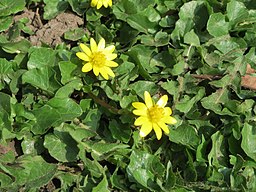Note: This is a project under development. The articles on this wiki are just being initiated and broadly incomplete. You can Help creating new pages.
Difference between revisions of "Ficaria verna - Fig buttercup"
(→References) |
|||
| Line 1: | Line 1: | ||
[[File:Ranunculus ficaria Aarberg2.JPG|thumb|right|''Ficaria verna'']] | [[File:Ranunculus ficaria Aarberg2.JPG|thumb|right|''Ficaria verna'']] | ||
| − | + | '''Ficaria verna''' commonly known as lesser celandine is a low-growing, hairless perennial flowering plant in the buttercup family Ranunculaceae native to Europe and west Asia. | |
| − | '''Ficaria verna''' commonly known as lesser celandine | ||
| − | |||
==Uses== | ==Uses== | ||
{{Uses|Haemorrhoids}}, {{Uses|Ulcers}}, {{Uses|Piles}}, {{Uses|Curing liver disorders}}, {{Uses|Perineal damage}}, {{Uses|Blotches}}, {{Uses|Pimples}}, {{Uses|Diarrhea}}, {{Uses|Sore throats}} | {{Uses|Haemorrhoids}}, {{Uses|Ulcers}}, {{Uses|Piles}}, {{Uses|Curing liver disorders}}, {{Uses|Perineal damage}}, {{Uses|Blotches}}, {{Uses|Pimples}}, {{Uses|Diarrhea}}, {{Uses|Sore throats}} | ||
| Line 36: | Line 34: | ||
==Identification== | ==Identification== | ||
===Leaf=== | ===Leaf=== | ||
| − | {{Leaf|Simple| | + | {{Leaf|Simple|Alternate|There is one leaf per node along the stem and the edge of the leaf blade has teeth}}<ref name="Leaf"/> |
===Flower=== | ===Flower=== | ||
| − | {{Flower|Unisexual|2-4cm long|Yellow|13| | + | {{Flower|Unisexual|2-4cm long|Yellow|13|There are two or more ways to evenly divide the flower}} |
===Fruit=== | ===Fruit=== | ||
| − | {{Fruit| | + | {{Fruit|General|2.6–2.8 mm|The fruit is dry but does not split open when ripe|With hooked hairs|Many}} |
===Other features=== | ===Other features=== | ||
| Line 72: | Line 70: | ||
<references> | <references> | ||
| − | <ref name="chemical composition">[https://www.researchgate.net/publication/259998140_Polyphenolic_compounds_from_flowers_of_Ficaria_verna_Huds | + | <ref name="chemical composition">[https://www.researchgate.net/publication/259998140_Polyphenolic_compounds_from_flowers_of_Ficaria_verna_Huds Chemistry]</ref> |
| − | <ref name="Leaf">[https://gobotany.newenglandwild.org/species/ficaria/verna/ | + | <ref name="Leaf">[https://gobotany.newenglandwild.org/species/ficaria/verna/ Charecteristics]</ref> |
| − | <ref name="How to plant/cultivate">[https://www.pfaf.org/user/Plant.aspx?LatinName=Ranunculus+ficaria | + | <ref name="How to plant/cultivate">[https://www.pfaf.org/user/Plant.aspx?LatinName=Ranunculus+ficaria Cultivation details]</ref> |
</references> | </references> | ||
Revision as of 11:43, 7 May 2020
Ficaria verna commonly known as lesser celandine is a low-growing, hairless perennial flowering plant in the buttercup family Ranunculaceae native to Europe and west Asia.
Contents
- 1 Uses
- 2 Parts Used
- 3 Chemical Composition
- 4 Common names
- 5 Properties
- 6 Habit
- 7 Identification
- 8 List of Ayurvedic medicine in which the herb is used
- 9 Where to get the saplings
- 10 Mode of Propagation
- 11 How to plant/cultivate
- 12 Commonly seen growing in areas
- 13 Photo Gallery
- 14 References
- 15 External Links
Uses
Haemorrhoids, Ulcers, Piles, Curing liver disorders, Perineal damage, Blotches, Pimples, Diarrhea, Sore throats
Parts Used
Chemical Composition
Chromatographic analysis confirmed the presence of phenolic acids: vanillic, synapic, ferulic, p-coumaric, caffeic, p-hydroxybenzoic, protocatechuic and p-hydroxyphenylacetic [1]
Common names
| Language | Common name |
|---|---|
| Kannada | |
| Hindi | |
| Malayalam | |
| Tamil | |
| Telugu | |
| Marathi | NA |
| Gujarathi | NA |
| Punjabi | NA |
| Kashmiri | NA |
| Sanskrit | |
| English | Lesser celandine, Fig buttercup |
Properties
Reference: Dravya - Substance, Rasa - Taste, Guna - Qualities, Veerya - Potency, Vipaka - Post-digesion effect, Karma - Pharmacological activity, Prabhava - Therepeutics.
Dravya
Rasa
Guna
Veerya
Vipaka
Karma
Prabhava
Habit
Identification
Leaf
| Kind | Shape | Feature |
|---|---|---|
| Simple | Alternate | There is one leaf per node along the stem and the edge of the leaf blade has teeth |
Flower
| Type | Size | Color and composition | Stamen | More information |
|---|---|---|---|---|
| Unisexual | 2-4cm long | Yellow | 13 | There are two or more ways to evenly divide the flower |
Fruit
| Type | Size | Mass | Appearance | Seeds | More information |
|---|---|---|---|---|---|
| General | 2.6–2.8 mm | The fruit is dry but does not split open when ripe | With hooked hairs | Many | {{{6}}} |
Other features
List of Ayurvedic medicine in which the herb is used
- Vishatinduka Taila as root juice extract
Where to get the saplings
Mode of Propagation
How to plant/cultivate
Prefers a moist loamy neutral to alkaline soil in full sun or shade[3]
Commonly seen growing in areas
Montane forest, Meadows, Shores of rivers, Shores of lakes.
Photo Gallery
References
External Links
- Ayurvedic Herbs known to be helpful to treat Haemorrhoids
- Ayurvedic Herbs known to be helpful to treat Ulcers
- Ayurvedic Herbs known to be helpful to treat Piles
- Ayurvedic Herbs known to be helpful to treat Curing liver disorders
- Ayurvedic Herbs known to be helpful to treat Perineal damage
- Ayurvedic Herbs known to be helpful to treat Blotches
- Ayurvedic Herbs known to be helpful to treat Pimples
- Ayurvedic Herbs known to be helpful to treat Diarrhea
- Ayurvedic Herbs known to be helpful to treat Sore throats
- Herbs with Dried folaige used in medicine
- Herbs with Whole herb used in medicine
- Herbs with common name in English
- Habit - Herb
- Index of Plants which can be propagated by Seeds
- Index of Plants which can be propagated by Cuttings
- Herbs that are commonly seen in the region of Montane forest
- Herbs that are commonly seen in the region of Meadows
- Herbs that are commonly seen in the region of Shores of rivers
- Herbs that are commonly seen in the region of Shores of lakes
- Herbs
- Ayurvedic herbs that don't have seed photos
- Ranunculaceae






